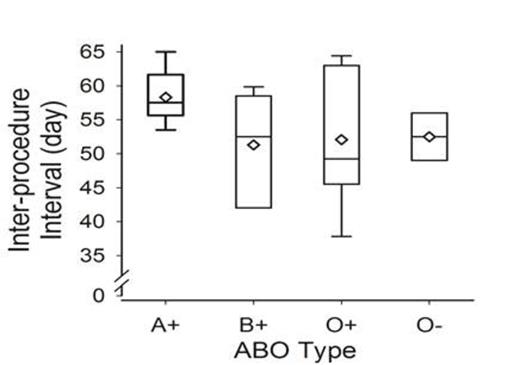Abstract
Background:
Sickle cell anemia (SCA) is a genetically inherited disorder that can lead to severe sequelae in any organ system. The most clinically devastating complications, e.g. stroke, are managed with chronic red blood cell (RBC) transfusions as curing the underlying SCA is often not an option. Chronic RBC exchange (RBCx), is an effective alternative to simple transfusions and often performed every 4-5 weeks. Isovolemic Hemodilution-Red Blood Cell Exchange (IHD-RBCx) is a modified RBCx method used at UT Southwestern Medical Center (UTSW) and increases the time interval between transfusions, i.e. inter-procedure interval (IPI), up to 9 weeks while maintaining the desired hemoglobin S targets at safe levels. This minimizes the overall lifetime procedures and blood exposures. The standard operating procedure for IHD-RBCx is published (Matevosyan et al, 2012). However, we observed IPI variability between patients in this chronic IHD-RBCx program. We sought to analyze hematologic characteristics in a cohort of adult SCA patients that may be associated with this noted variability.
Methods:
This IRB approved cross-sectional study evaluated medical and blood bank records of adult patients with SCA, i.e. hemoglobin SS or Sβ0 thalassemia genotypes, undergoing chronic IHD-RBCx at UTSW adult hospital sites between January 1, 2012 and December 31, 2013. Excluded participants were those with autoimmune disease, non-compliance with IHD-RBCx leading to delays > 7 days, or use of hydroxyurea or steroids within four months of the study period. Patients with < 5 exchanges were excluded as several procedures are needed to determine baseline IPIs. The primary indication for IHD-RBCx was secondary stroke prevention. Three subjects had alternative indications (i.e. recurrent severe acute chest syndrome that failed hydroxyurea therapy, intractable pain and severe anemia ineligible for iron chelation due to end-stage renal disease). Median values during the 2 year study were determined for the IPI, laboratory, and RBC properties for use in subsequent analyses. Correlation and multiple regression analyses were performed to determine variables predictive of IPI.
Results:
Twenty-four SCA patients in this chronic IHD-RBCx transfusion program met inclusion criteria of which 14 (58.3%) were female with age range 18-41 years. Three subjects had incomplete data. The median number of packed RBC (pRBC) units per IHD-RBCx was 8 (range: 6-11 units). The median volume per unit of pRBCs was 304.5 mL (range: 298.8-326.5 mL) with average age of the pRBCs 5.8 days ± 0.7 days. The median IPI was 55.8 days (range: 36.0-65.5 days).
The strongest correlation with IPI was the change from the mid to post-procedure hemoglobin and hematocrit values, r=0.56, p=0.005 and r=0.57, p=0.003, respectively. Participants with documented direct antiglobulin test positivity (n=7), compared to those who remained negative (n=16), had 4.9 days increased IPI. This difference was not statistically significant, p=0.19. ABO differences in blood type also did not show statistical significant differences. However, A+ subjects had a 58 day interval compared to 51, 52, 53 days for B+, O+, O- respectively (Figure). In multiple regression models, log blood urea nitrogen (BUN) and post-procedure white blood cell count (WBC) were found to be independent predictors of IPI, beta=-11.3, p=0.04 and -2.1, p=0.03 respectively, with adjusted R2=0.31.
Conclusions:
Chronic IHD-RBCx effectively treats severe SCA complications. Discontinuing transfusions lead to repeat stroke events or the recurrence of disease manifestations making chronic transfusion programs an indefinite therapy. Outside of the expected correlation between the IPI and hemoglobin/hematocrit, WBC and BUN were found to have negative associations with IPIs. The decrease in WBCs is likely due to the direct clearing effect by the operating system. The association between BUN and IPI may imply relationship with renal function. Interestingly, association with creatinine was not statistically significant. The study is limited by the small sample size. Future studies of similar cohorts should prospectively evaluate target mechanisms which may lead to interventions that can minimize lifetime blood exposures given the growing demands for continued RBCx in severe SCA.
No relevant conflicts of interest to declare.
Author notes
Asterisk with author names denotes non-ASH members.


This feature is available to Subscribers Only
Sign In or Create an Account Close Modal